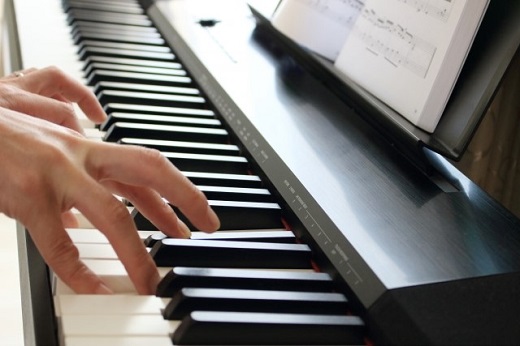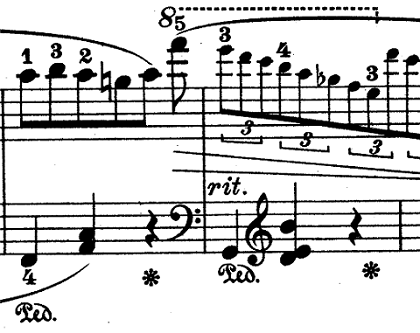
When asked, “What comes to mind when you think of Chopin?” many children learning piano quickly respond, “Minute Waltz!”
This iconic piece is so famous and consistently ranks as one of the most desired recital pieces. Its brilliance, charm, and elegance captivate pianists of all levels.
In this article, we’ll explore three essential tips to help you perform this stunning piece beautifully!
Contents
The “puppy” is George Sand’s pet dog
First, let’s learn about the origins of this piece!This composition came about when George Sand, Chopin’s lover, asked him to create a piece inspired by her pet dog. The adorable dog would spin around and around chasing its tail. Perhaps Chopin himself shared in the delight of watching this endearing sight alongside Sand.
Remembering this story is crucial when playing this piece!
If you forget, and simply play it as a series of notes without emotion, your teacher might scold you like mine did:
“Well, that’s more of a ‘Pig Waltz’ than a ‘Puppy Waltz’! How disrespectful to Chopin!”
Picture a fluffy white puppy joyfully running across vivid green grass under a clear blue European sky. Strive to convey a sound worthy of this image.
(Well, I’m not sure if the puppy was actually white—this is just for imagery! 😄)

What is the difficulty level of this piece?
According to the Zen-on Piano Grade Chart, this piece is rated C (Intermediate) on a scale from A to F.If you can confidently play the earlier pieces in Czerny’s 30 New Studies in Technique, the fingerings of the “Minute Waltz” should pose no trouble.
However, the piece is in D-flat major, with many flats in its key signature. If you’re uncomfortable with black keys, sight-reading might be a bit tricky. But the abundance of flats lends the piece its mature and refined quality.
This combination of playfulness and elegance likely contributes to its enduring popularity.
By the way, while the nickname “Minute Waltz” is well-known, its formal title is Op. 64-1, the first of three pieces in Chopin’s Op. 64.
Wondering if there’s a second and third piece? If so, you’re quite perceptive!
Yes, Op. 64 includes a second piece, the well-known Waltz in C-sharp minor, full of Chopin’s characteristic melancholy. The third piece is the vibrant Waltz in A-flat major.
Chopin often pairs contrasting emotions in his works: a bright piece followed by a melancholic one.
Both the second and third waltzes are slightly more challenging than the first. Once you’ve mastered the “Minute Waltz”, consider taking on the others!
Performance Tip #1: Let your left hand be the conductor!
While the right hand often steals the show as it dances across the keyboard, the left hand holds the key to a polished performance.If your left hand is clumsy, the music will sound sluggish and unbalanced.

Begin by isolating the first beat of each measure in the left hand, and practice singing or humming the bassline until it feels second nature.
Once the bassline is well-established, play the second and third beats more softly than the first. This is a critical point!
Most measures in this piece consist of:
First beat (bass) vs. Second and third beats (chords).
Numerically, it’s:
1 vs. 3 + 3
In other words:
1 vs. 6
Now imagine:
One elephant vs. six elephants.
If you maintain this imbalance throughout the piece, it would be:
“Too loud!”
To prevent this, aim for:
One elephant vs. six squirrels.
Keep the first beat slightly heavier (perhaps not as heavy as an elephant!) while playing the second and third beats lightly and delicately with a supple wrist.
This will bring out the elegance and clarity that make this waltz so special.
Performance Tip #2: Mastering the Trill
Now, the most iconic part of this piece is the trill that appears right at the beginning!!Not good at trills?
No worries!!
The trills in this piece only involve the most agile fingers of your right hand: the 2nd, 3rd, and 4th fingers!!
The long trill spanning four measures after the middle section only uses the right-hand index and middle fingers!!
This is not the kind of impossible trill involving the left-hand ring finger and pinky.
Practice diligently every day without hesitation.
For trill practice, try moving your fingers on a desk or any flat surface instead of a piano. Since there’s no strain on your fingers like on the keyboard, you can practice with relaxed hands and good form anytime.
While practicing, be sure to work on both moving the two fingers widely and keeping the movements as small and minimal as possible. This will help you create a trill with expression, allowing you to play a trill with a sense of depth, like a little puppy running toward you from afar.
By the way,

There are also scores without the opening trill like this.
This varies depending on the publisher, so follow the score you are using.
The commonly used editions include Zen-On, the Paderewski edition preferred by many piano teachers, and the Ekier edition, which has been gaining popularity recently due to its use in the Chopin Competition.
Performance Tip #3: Play the Arrival Notes of the Right Hand Gracefully
The theme of this piece that follows the opening trill is well-known—a melody so endearing that it feels like an adorable puppy running toward you, making you want to hug it.It’s said that Chopin improvised this melody, which leaves no doubt about his genius.
But!!
If you play this melody strictly according to the score’s crescendo markings, it becomes disastrous.
So-La-Do-Si-So-La-Do-Si-So-La-Do-Si-So-La-Do-Si-So-La-Si-Do-Re-Mi-Fa-So “Si!!”
Yikes!!!!!!
It’s like a Tosa dog!!!!
It’s about to bite!!
Therefore, approach the arrival note “Si” of this melody with a touch of gentleness, letting the sound resonate gracefully upward, like an elegant and refined tone.
Avoid tensing your palm and focus the weight only on your fingertips.
Mastering this technique will instantly elevate the quality of your performance.
Since this melody appears repeatedly throughout the piece,

you can also apply it to the highest note “Fa” at the end of the piece.
That said, this playing style is divisive. Some people prefer a clear, vibrant sound played firmly, as it gives the music a strong presence.
The method I’ve introduced here is merely my personal preference.
But that’s part of what makes music interesting: what matters most is how *you* want to play as the performer.
Try various approaches and complete your own unique rendition of this piece!
Summary
The difficulty level of the “Minute Waltz” is intermediate.When performing it:
– Let your left hand act like a conductor,
– Play the trills brilliantly, and
– Pay close attention to the arrival notes in the right-hand melody within each phrase.
By following these tips, your rendition of this waltz will undoubtedly level up!
The middle section, with its warm and dreamy ambiance, is also incredibly charming.
Since it’s called the “Minute Waltz,” many people aim to finish it within a minute by playing quickly and energetically.
However, it might be even more important to perform with beautiful sounds filled with love for the little puppy.
May your performance be a wonderful waltz!
Cheering you on!
Free Sheet Music for the “Minute Waltz”
- IMSLP (Sheet Music Link)
This article was created using this score, which is a public domain score published by Peters in 1905. - Mutopia Project (Sheet Music Link)
This is a recently formatted, beautifully designed public domain score.
List of Articles on Chopin's Waltz No. 6 “Minute Waltz (Petit Chien)” in D-flat Major, Op. 64-1
- Perfect for a Piano Recital! Chopin's “Minute Waltz”: Difficulty and 3 Tips for Playing It 2017/5/25 ←Currently Viewing Article
- もぐらが教える8つのコツ!ショパン『子犬のワルツ』難易度と弾き方とは? 2017年7月6日
- 子犬のワルツ。ショパンの名曲のかんたんな弾き方、難易度も解説。(ワルツ第6番変ニ長調Op.64-1) 2018年3月9日
- ショパン作曲『子犬のワルツ』の難易度は?弾き方を極める7つのコツ 2019年8月1日
List of Articles on Chopin’s Waltzes
- Ranking Chopin’s Waltzes by Difficulty: A Piano Teacher’s Perspective 2017/3/17
- Perfect for a Piano Recital! Chopin's “Minute Waltz”: Difficulty and 3 Tips for Playing It 2017/5/25 ←Currently Viewing Article
- How to Master Chopin’s “Grand Valse Brillante”: Difficulty Level and Essential Waltz Techniques 2017/6/2
- 自分に合った指番号で弾く!ショパン「華麗なる大円舞曲」難易度と弾き方 2017年6月29日
- もぐらが教える8つのコツ!ショパン『子犬のワルツ』難易度と弾き方とは? 2017年7月6日
- これで挫折知らず!ショパン『ワルツ第7番op64-2』弾き方のコツと難易度 2017年7月14日
- 華やか&叙情的!ショパン『ワルツ第14番ホ短調遺作』弾き方のコツと難易度 2017年8月6日
- ロマンティックな恋!ショパン『ワルツ第9番op.69-1』の弾き方と難易度(『別れのワルツ』『告別』) 2017年11月8日
- 華やかなワルツの世界!ショパン「華麗なる大円舞曲」弾き方と難易度 2017年12月6日
- 初めてショパンを弾く人へ!『ワルツ第10番op.69-2』の弾き方と難易度 2017年12月16日
- 子犬のワルツ。ショパンの名曲のかんたんな弾き方、難易度も解説。(ワルツ第6番変ニ長調Op.64-1) 2018年3月9日
- おすすめしたい隠れた名曲!ショパン:ワルツ第15番ホ長調遺作の弾き方と難易度 2018年3月19日
- 一音入魂!ショパン:ワルツ第3番(華麗なる円舞曲)の難易度と弾き方(Op.34-2イ短調) 2018年5月19日
- ショパン作曲『子犬のワルツ』の難易度は?弾き方を極める7つのコツ 2019年8月1日















